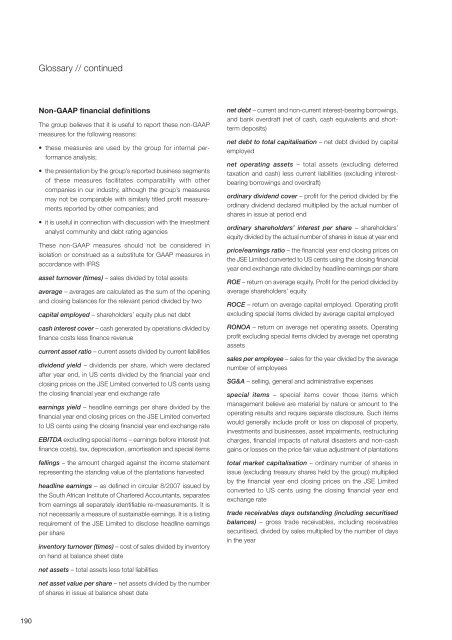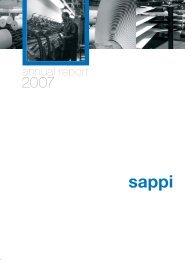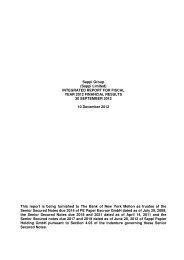2008 Annual report - Sappi
2008 Annual report - Sappi
2008 Annual report - Sappi
Create successful ePaper yourself
Turn your PDF publications into a flip-book with our unique Google optimized e-Paper software.
Glossary // continued<br />
Non-GAAP financial definitions<br />
The group believes that it is useful to <strong>report</strong> these non-GAAP<br />
measures for the following reasons:<br />
• these measures are used by the group for internal per -<br />
formance analysis;<br />
• the presentation by the group’s <strong>report</strong>ed business segments<br />
of these measures facilitates comparability with other<br />
companies in our industry, although the group’s measures<br />
may not be comparable with similarly titled profit measure -<br />
ments <strong>report</strong>ed by other companies; and<br />
• it is useful in connection with discussion with the investment<br />
analyst community and debt rating agencies<br />
These non-GAAP measures should not be considered in<br />
isolation or construed as a substitute for GAAP measures in<br />
accordance with IFRS<br />
asset turnover (times) – sales divided by total assets<br />
average – averages are calculated as the sum of the opening<br />
and closing balances for the relevant period divided by two<br />
capital employed – shareholders’ equity plus net debt<br />
cash interest cover – cash generated by operations divided by<br />
finance costs less finance revenue<br />
current asset ratio – current assets divided by current liabilities<br />
dividend yield – dividends per share, which were declared<br />
after year end, in US cents divided by the financial year end<br />
closing prices on the JSE Limited converted to US cents using<br />
the closing financial year end exchange rate<br />
earnings yield – headline earnings per share divided by the<br />
financial year end closing prices on the JSE Limited converted<br />
to US cents using the closing financial year end exchange rate<br />
EBITDA excluding special items – earnings before interest (net<br />
finance costs), tax, depreciation, amortisation and special items<br />
fellings – the amount charged against the income statement<br />
representing the standing value of the plantations harvested<br />
headline earnings – as defined in circular 8/2007 issued by<br />
the South African Institute of Chartered Accountants, separates<br />
from earnings all separately identifiable re-measurements. It is<br />
not necessarily a measure of sustainable earnings. It is a listing<br />
requirement of the JSE Limited to disclose headline earnings<br />
per share<br />
inventory turnover (times) – cost of sales divided by inventory<br />
on hand at balance sheet date<br />
net debt – current and non-current interest-bearing borrowings,<br />
and bank overdraft (net of cash, cash equivalents and shortterm<br />
deposits)<br />
net debt to total capitalisation – net debt divided by capital<br />
employed<br />
net operating assets – total assets (excluding deferred<br />
taxation and cash) less current liabilities (excluding interestbearing<br />
borrowings and overdraft)<br />
ordinary dividend cover – profit for the period divided by the<br />
ordinary dividend declared multiplied by the actual number of<br />
shares in issue at period end<br />
ordinary shareholders’ interest per share – shareholders’<br />
equity divided by the actual number of shares in issue at year end<br />
price/earnings ratio – the financial year end closing prices on<br />
the JSE Limited converted to US cents using the closing financial<br />
year end exchange rate divided by headline earnings per share<br />
ROE – return on average equity. Profit for the period divided by<br />
average shareholders’ equity<br />
ROCE – return on average capital employed. Operating profit<br />
excluding special items divided by average capital employed<br />
RONOA – return on average net operating assets. Operating<br />
profit excluding special items divided by average net operating<br />
assets<br />
sales per employee – sales for the year divided by the average<br />
number of employees<br />
SG&A – selling, general and administrative expenses<br />
special items – special items cover those items which<br />
management believe are material by nature or amount to the<br />
operating results and require separate disclosure. Such items<br />
would generally include profit or loss on disposal of property,<br />
investments and businesses, asset impairments, restructuring<br />
charges, financial impacts of natural disasters and non-cash<br />
gains or losses on the price fair value adjustment of plantations<br />
total market capitalisation – ordinary number of shares in<br />
issue (excluding treasury shares held by the group) multiplied<br />
by the financial year end closing prices on the JSE Limited<br />
converted to US cents using the closing financial year end<br />
exchange rate<br />
trade receivables days outstanding (including securitised<br />
balances) – gross trade receivables, including receivables<br />
securitised, divided by sales multiplied by the number of days<br />
in the year<br />
net assets – total assets less total liabilities<br />
net asset value per share – net assets divided by the number<br />
of shares in issue at balance sheet date<br />
190
















